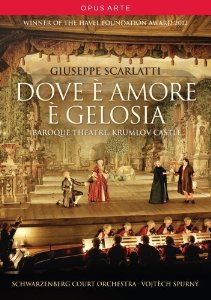
Now that many of us are leaping to the altar unfettered by those pesky legalities of yore the problem of what to put on the bridal (or groomal) registry has become an atrocious head scratcher. So many of us have had housekeeping set up for so long now that we really don’t want for anything.
Leave it to Prince Joseph Adam of Schwarzenburg, Duke of Krumlov to choose a most inspired present to give to his son upon his wedding in 1768; an opera. Commissioned for the occasion from Giuseppe Scarlatti, who history posits was nephew to either the more well-known Alessandro or Domenico, and was the music instructor for all the Schwarzenberg children.
Since the Count’s predilections ran towards the buffo a libretto was drawn up by Marco Coltellini entitled, Dove è amore è gelosia (Where there is love, there is jealousy). The whole thing plays like a Nozze di Figaro starter kit. The widowed Marquise Clarice thinks her latest beau, Count Orazio, is too jealous and endeavors to teach him a lesson with the help of her maid, the aptly named Vespetta, and his manservant, Patrizio. Fake mustaches are worn, bushes are rustled, and notes are passed in class. If the last scene didn’t find one of the gentlemen enjoying life en travesti I was going to lose a bet with myself. Fear not!
It’s a charming piece on many levels, musically swift and bright and easy on the ear. In the accompanying documentary, the conductor of the sprightly Schwarzenberg Court Orchestra for the evening, Vojtech Spurny, tries to convince us that one of the arias for the Marquise really raises the whole above the level of it just being a mere divertissement. I remained charmed but unconvinced.
This little gem of a DVD comes to us from our friends at Opus Arte and although it contains a charming opera heretofore unperformed, in this century or the one before, its focus is really on the extraordinary baroque theatre that it’s performed in and its restoration.
A very young cast chosen from the Prague National Theater brings a slight air of collegiate theatricals to the proceedings but it’s all for the good as the story veers closer and closer to farce. Their enjoyment levels are palpable and their names are all nearly unpronounceable without serious effort. Sopranos Lenka Máciková as the Marquise and Katerina Knezíková as Vespetta, show the most polish. The men are a tad rougher at the edges, even though Ales Briscein as the Count and Jaroslav Brezina as Patrizio are near-perfect foils. They’re all especially limber in the recitative which helps.
Compliments should go to Jana Zborilová for her lovely costumes which have no trouble concurrently blending in and standing out from their overtly baroque surroundings. Also, the very witty staging by Ondrej Havelka puts a fresh face on a lot of very old routines
The glory of this performance and the true star of the evening is the theater of Cesky Krumlov itself. This last true baroque wooden theater in the world that hasn’t been modernized is now restored with painstaking attention to detail. The very first set change–and there are many in the slim 80 minutes it takes for this piece to play—won my astonished gasp as I watched the flies, wings, and backdrop switch out simultaneously in near-perfect synchronicity.
Trap doors are even used to move furniture set pieces at times just for fun. The stage transforms from grand hall to garden to library and back in almost the blink of an eye, all lit by candlelight which bathes the singers in a warm glow. The role of a Servant doubling as the Stage Manager is played with a wry eye by Bohumil Klepl and allows us to watch the scene shifts and special effects from backstage as well.
An hour-long documentary goes into serious detail about the history of the theater and the opera, the manuscript of which was gathering dust in the Castle library all this time, and it’s well worth watching. Before pictures of the theater in total disrepair are shocking and the working model for the riggings is truly fascinating.
I don’t know why on British-manufactured videos I have to change the output format on my monitor from 1080p to 1080i to quell the picture shudders but I do and it works. DTS Digital sound is crystal and the picture is so good it makes you feel like you’re there. For lovers of the baroque, or theater itself. this really is a must have. Though the musical performance itself is slight it’s eminently enjoyable and gives us a window to a time centuries back.

























Comments